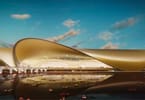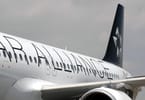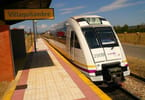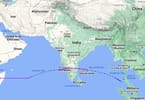TOKYO – An ambitious project to build Japan’s first ever passenger jet received a huge boost Friday, landing a 100-plane order worth up to four billion dollars from a US regional airline.
The state-backed Mitsubishi Regional Jet (MRJ) is expected to take to the skies in 2014, carrying Japan’s hopes of developing a full-fledged civil aviation industry with it.
Mitsubishi Heavy Industries, the company developing the 70-90 seat airliner, announced that it had signed a letter of intent with US carrier Trans States for 50 firm orders and the same number of options.
Mitsubishi declined to say how much the latest deal was worth, but the catalogue price of each jet is 40 million dollars.
It is the second order for the MRJ, which aims to meet growing demand for fuel-efficient planes.
The project officially got off the ground in 2008 after launch customer All Nippon Airways agreed to buy up to 25 of the jets, the first of which are scheduled to be delivered in early 2014.
But it quickly flew into turbulence as the global economic downturn unleashed a severe slump in the aviation industry that forced many carriers, including Japan Airlines, to slash jobs and routes to keep flying.
“This is a very proud moment for us,” said Hideo Egawa, president of Mitsubishi’s aircraft division.
“The world has high expectations for the MRJ. This is especially true in the US,” where airlines operate jets of up to 90 seats on many routes, Egawa said.
The Mitsubishi jet project, which has financial backing from Toyota Motor, is competing with small aircraft produced by Canada’s Bombardier and Brazil’s Embraer, as well as jets designed by Russian and Chinese firms.
“Making a decision of this size in this economic situation was difficult, ” said Richard Leach, president of Trans States Holdings.
“But when these aircraft come into the market it’s at a time when there’s going to be a need in the US to replace aircraft.
“We want to be at the front of the line before there starts to be a feeding frenzy on wanting this technology.”
The group, based in Missouri, operates Trans States Airlines and GoJet Airlines, and operates feeder services for United Airlines and US Airways. It has been a customer adviser for Mitsubishi since the past five years.
The plane saves 20 to 30 percent in fuel burn per hour compared with other jets in the same category, Mitsubishi officials said.
Fuel costs are “very important”, said Trans States’ Leach.
The jet incorporates a geared turbofan engine developed by Pratt Whitney, a relatively new technology regarded as a fuel sipper due to a system that allows the engine’s fans to operate at a different speed to the turbine.
The engine is also used in Canada’s Bombardier aircraft.
The MRJ would be the first commercial passenger aircraft in four decades — and the first jet airplane — to be developed in Japan.
Japan has in the past developed a turboprop plane, the YS-11, which was the only Japanese airliner built since World War II. It made its debut flight in 1962 but had limited success with production ending in 1974.
The firm plans to build the aircraft at parent company Mitsubishi Heavy’s factory in central Nagoya prefecture, starting at 24 aircraft per year in the early stages, and increase the amount to 72.
Mitsubishi, advised by US aircraft maker Boeing, said earlier this month it had delayed the delivery slightly to revamp the design by increasing cabin and cargo space and switching to aluminium for the wings, from carbon-fibre.
WHAT TO TAKE AWAY FROM THIS ARTICLE:
- The jet incorporates a geared turbofan engine developed by Pratt Whitney, a relatively new technology regarded as a fuel sipper due to a system that allows the engine’s fans to operate at a different speed to the turbine.
- The firm plans to build the aircraft at parent company Mitsubishi Heavy’s factory in central Nagoya prefecture, starting at 24 aircraft per year in the early stages, and increase the amount to 72.
- The project officially got off the ground in 2008 after launch customer All Nippon Airways agreed to buy up to 25 of the jets, the first of which are scheduled to be delivered in early 2014.






















